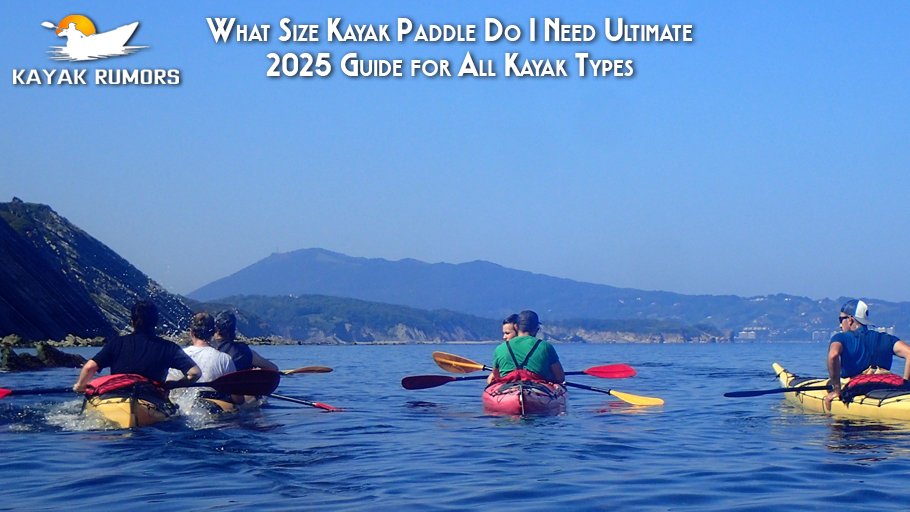When you paddle out, asking what size kayak paddle do I need is one of the most useful questions you’ll ask. The paddle isn’t just a tool—it shapes your comfort, power, and enjoyment on water. Pick the wrong one and you’ll feel the effort in your shoulders; pick the right one and strokes feel natural.
This guide from Kayak Rumors shows how to find the right paddle size for your body, kayak, style, and water conditions. I’ll walk through measurements, paddle styles, blade types, material, real world testing, plus tips many competitors leave out. Use this to choose a paddle that you’ll love using.
Why Paddle Size Matters
How Paddle Size Affects Your Paddling
If you know what size kayak paddle do I need, you avoid strain, wasted energy, and awkward technique. Correct size lets you:
- Reach water without leaning too far sideways.
- Use your core more and arms less (which helps endurance).
- Maintain good posture—less risk of back/shoulder pain.
- Control your kayak well, especially when turning and handling wind or waves.
What Happens If Paddle is Too Short / Too Long
| Too Short | Too Long |
|---|---|
| Your arms swing inward toward kayak sides; risking banging knuckles. | You over‑extend your reach; shoulders may strain. |
| You lean forward or twist too much. | May paddle slower, waste energy, fatigue faster. |
| Blade won’t reach water well. | Harder to make clean, powerful strokes. |
Knowing what size kayak paddle do I need helps avoid these problems.
Key Measurements & Variables
To decide what size kayak paddle do I need, you must consider several measurements + variables.
Your Height, Arm Span, Torso Height
- Height gives you first clue. Taller people typically need longer paddles.
- Arm span (fingertip to fingertip) helps refine that. If your arm span is long relative to height, you might go slightly longer.
- Torso height (from seat or water line to top of your chest or nose) also matters. If your torso is long, you reach further when sitting, so could use more length.
Kayak Width (Beam)
Kayak width is critical. A narrow kayak needs shorter paddle; wide kayak needs longer to get blade in water without hitting the side. As width increases, the required paddle size increases.
- Measure kayak width at its widest point.
- If kayak is over ~32 inches wide, you’ll likely need a longer paddle than charts suggest to compensate.
Seat Height & Seating Position
- Elevated seats (sit‑on‑top kayaks, fishing kayaks, or seats with cushion) raise your torso. That increases the distance from you to water surface. So you’ll need a longer paddle.
- Sitting low → less paddle needed.
Paddling Style: High‑Angle vs Low‑Angle
- Low‑angle paddling: strokes more horizontal; relaxed. Best for touring, long distances, calm water. These usually work better with slightly longer paddle.
- High‑angle paddling: more vertical strokes; more power per stroke; useful in whitewater or when needing speed. These prefer somewhat shorter paddles for quicker response.
Sizing Charts & Guidelines
Here are data‑driven charts and recommendations to help answer what size kayak paddle do I need, according to height + kayak width + style.
Standard Paddle Size Charts
These charts are drawn from various trusted sources (Sportsman’s Warehouse, KayakVista, Outdoor Doer, Academy).
| Paddler Height | Kayak Width Under 23 in | Kayak Width 23‑28 in | 28‑32 in | Over 32 in |
|---|---|---|---|---|
| Under ~5′ (≈152 cm) | ~200‑210 cm | ~210‑220 cm | ~220‑230 cm | ~230‑240 cm |
| 5′0″‑5′6″ (~152‑168 cm) | ~210‑215 cm | ~220‑230 cm | ~230‑240 cm | ~240‑250 cm |
| 5′6″‑6′0″ (~168‑183 cm) | ~220‑225 cm | ~230‑235 cm | ~240‑250 cm | ~250‑260 cm |
| Over ~6′ (~183 cm) | ~220‑230 cm | ~230‑240 cm | ~250‑260 cm | ~260‑270 cm |
Adjusted Charts for Paddling Style
If you use high‑angle style or whitewater, shorten 5‑10 cm from the standard chart. If low‑angle style + calm water + elevated seat, you may add 5‑10 cm. Sources confirm this approach.
Whitewater / Rough Water Size Guideline
For whitewater or very active paddling:
- For paddlers under ~5′6″, 188‑200 cm often works.
- For taller paddlers, 190‑210 cm, depending on width and style.
Using these, you can pinpoint what size kayak paddle do I need for your specific condition.
“Hands‑On Tests” to Check Fit
Charts are helpful, but real paddling or simple physical tests solidify your choice. Here are tests many competitors seldom explain clearly.
Stand‑Up Blade Overhead Test
- Stand straight beside a paddle held vertically (one blade on the ground, the other up).
- Raise the arm closest to the paddle, reach up.
- Try to curl your fingers over the top edge of the blade.
- If your fingers cover too much of the blade → paddle is too short.
- If you can’t reach at all → paddle is too long.
- If you just touch with fingertips or the first joint → near correct. This helps decide what size kayak paddle do I need in practice.
On‑Water 90‑Degree Elbow Test
- Sit properly in kayak (feet resting, back straight).
- Hold paddle horizontally in front, arms bent so elbows about 90°.
- Check if your hands are positioned about 2/3 of the span between blade and shaft junction.
If elbows open too much, paddle too long; if hands cramped or inside hull edges, maybe too short.
Try Different Paddles
If you can, borrow or rent paddles of two sizes near your chart result. Paddle for at least 15‑30 minutes. Note fatigue, reach, ease of pulling stroke, whether you’re banging boat sides. Whichever size feels more comfortable is probably closer to correct.
Material, Blade Shape & Other Features That Influence Needed Size

Even after you calculate what size kayak paddle do I need by weight charts, height, width, style, material and blade shape shift the real‑world feel.
Materials: How They Change Weight & Feel
- Aluminum shafts + plastic polymer blades → heavy, less expensive. Heavier paddle means every extra cm adds fatigue.
- Fiberglass or composite shafts reduce weight; carbon fiber is lightest, but can cost more.
- Light paddle helps especially in longer journeys once size is set.
Blade Shape & Design
- Wider blade pushes more water; good power but more effort. If blade is wide, sometimes shorter shaft helps prevent overreach.
- Narrow blades are easier to pull, less resistance; may allow longer shaft.
- Symmetrical vs asymmetrical blades: blade shape affects how water enters and exits, affecting how hard strokes feel.
- Feathering (angle between blades) reduces wind resistance and may slightly affect how you orient the paddle, which can influence comfort and perceived effective length.
Fixed vs Adjustable vs Telescoping Ferrules
- Fixed paddles are one length, often lighter, and generally strong.
- Adjustable paddles let you test sizes, are flexible if multiple people use kayak or you use different styles. But mechanisms may add weight & weak points.
If you’re unsure what size kayak paddle do I need, adjustable paddle lets you fine‑tune.
Special Situations & Less Common Scenarios
Some paddle uses or kayak types need tweaks that aren’t always covered well elsewhere.
Fishing Kayaks & Elevated Seats
If you use a kayak with high seats (common in fishing kayaks), or use platform accessories that raise seating, your distance to water increases. You’ll need to add some length. Often +5‑10 cm over chart recommendation.
Sit‑On‑Top Kayaks, Inflatable Kayaks
- Sit‑on‑top kayaks often sit higher and are wider. That pushes you toward longer paddle lengths.
- Inflatable kayaks often have multiple tubes, side baffles; the waterline may be further from you. Add extra length.
Youth / Kids / Smaller Paddlers
For kids or small paddlers, focus more on torque and blade area. A light paddle with shorter shaft but appropriately sized blades works better than a long paddle that offers reach but tires them out.
Touring vs Whitewater vs Casual Paddling
- Touring: long trips, calm water, often low‑angle strokes → paddle may be longer, lighter, narrower blades.
- Whitewater: quick maneuvers, high‑angle strokes → shorter paddle, wide blade.
- Casual/paddling for pleasure: comfort over speed; pick a size slightly toward comfort even if less “ideal” per performance charts.
Answering Common Questions (FAQ)
Here are detailed answers to FAQs around what size kayak paddle do I need.
1: What size kayak paddle do I need for a 10‑foot kayak?
If your kayak is about 10 ft long and fairly wide (say 28‑32 in), first check your height: someone around 5′6″‑6′ likely fits paddle in ~230‑240 cm range. If your seat is elevated, add ~5 cm. If shorter person, you might go ~220‑230 cm.
2: If I paddle in both calm lake & rough water, what size paddle should I pick?
Pick a size based on your most frequent conditions. If you paddle mostly calm water but sometimes rough, go with chart for calm (slightly longer) and pick a paddle with good blade design & material so it handles both. If switching often, consider adjustable paddle.
3: Can I just follow manufacturer chart and be done?
Charts are great starting points but they don’t know your exact setup (seat height, body geometry, strength, style). Use chart, then do stand‑test and water test. That gives fuller answer to what size kayak paddle do I need.
4: How much difference does 5‑10 cm make?
Quite a lot. Even 5 cm too short or too long becomes noticeable after many strokes. Fatigue, awkward reach, hitting kayak sides. You might tolerate it for short trips, but for long paddles, comfort matters.
5: If I’m tall but kayak is very narrow, do I need to go tall or stay in smaller size?
You can balance. A tall paddler in narrow kayak might not need as long a paddle as chart suggests because width is small. Use your height + kayak width + test methods. Sometimes a paddle a little shorter than what tall + wide chart suggests feels better.
Expert References
To help you further decide what size kayak paddle do I need, here are trusted external resources with charts, expert tips, tools, and comparisons:
- Sportsman’s Warehouse – Paddle sizing charts by height & kayak width.
- KayakVista – Size guides including adjustments for seat height & style.
- Outdoor Doer – Advice on how blade shape, body dimensions, and style work together.
- Academy Sports – Method combining torso height, style (high vs low angle) and kayak width.
- Bob’s Up The Creek Outfitters – Practical chart + notes for wider kayaks & adjustable paddles.
How to Choose & Buy Once You Know “What Size Kayak Paddle Do I Need”
Using Your Measurements & Tests to Pick a Specific Paddle
- Use your height + kayak width + seating height + style → pick a range from charts.
- Do the stand test (blade overhead) & 90‑degree elbow test. See how close your chart result feels.
- If possible, test paddles on water for at least 15‑30 min. Note fatigue, ease of stroke, whether you feel comfortable reach and power.
Buying Tips
- Try before you buy (rental shops, demo days).
- Consider adjustable paddle if unsure or multiple users.
- Lightweight materials pay off over time.
- Blade shape: select one that matches how you paddle (speed, calm waters vs maneuvering).
Maintenance & Long‑Term Use
- Rinse off salt or sand to avoid wear.
- Store paddles off‐ground, avoid warping, keep out of extreme heat.
- Inspect joints if adjustable.
- Replace when blade shape is worn, shaft flexes, or damage occurs.
Final Thoughts
Picking what size kayak paddle do I need takes a mix of measurement, testing, style, and common sense. Use your body size, kayak width, and how and where you paddle to guide you. Then fine‑tune by feeling: overhead reach, stroke power, comfort.
If you want the best experience, don’t settle for “close enough.” Choose a paddle that fits you well—it will make paddling more fun and less tiring.
Call to Action
Ready to find the paddle that fits you best? Check out detailed paddle reviews and size comparison articles on Kayak Rumors. Sign up for our newsletter so you get sizing charts, expert tips, and deals straight to your inbox. Share in the comments: what paddle length did you pick, and how does it feel? Your insight helps others decide “what size kayak paddle do I need” too.



